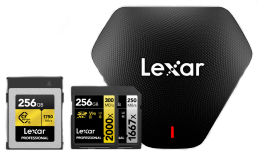
We understand that selecting the right SD card for camera performance and speed is crucial for capturing stunning images and videos.
With a variety of sizes, speeds, and features available, making an informed choice can significantly enhance your creative workflow and ensure that every moment is captured flawlessly.
In this guide, we’ll break down everything you need to know about SD cards, helping you make the perfect choice to meet your specific needs and elevate your photography and videography to the next level.
Understanding SD Card Types and Formats
There are different SD card types, but for your camera, you’ll likely be choosing between SDHC (Secure Digital High Capacity) and SDXC (Secure Digital Extended Capacity) cards. Both offer generous storage for your photos and videos.
The main difference lies in their storage capacity. SDHC cards range from 2GB to 32GB, making them suitable for entry-level cameras and casual photography.
If you’re shooting high-resolution images or recording a lot of video, an SDXC card will be a better choice, offering storage from 64GB up to 2TB.
What Does UHS Stand for in SD Cards?
The Ultra High Speed (UHS) bus interface found on some SD cards dramatically boosts the data transfer speed, especially for video. You’ll find UHS-I and UHS-II, with UHS-II offering even faster speeds.
However, UHS-II requires a compatible camera for full performance. A UHS-I memory card is a great option if your camera does not support the faster speeds of UHS-II.
Deciphering Speed Class Ratings and Their Importance for Photographers
Knowing the different speed class ratings of SD cards and how they apply to photography and videography will help you choose a card that can keep up with your camera’s performance and demands. SD cards use speed class ratings to measure data transfer speeds, which are crucial for camera performance.
What is Speed Class?
Speed class ratings measure the minimum sustained write speed an SD card can maintain. These ratings are critical for tasks like continuous shooting or recording high-quality video. They are represented by a number within a circle, such as Class 2, 4, 6, or 10, indicating the minimum write speeds in MB/s (megabytes per second).
The higher the number, the faster the card. Fast read speeds let you quickly transfer files to your computer for editing or sharing, and the best memory cards offer a good balance of speed and storage capacity.
What is UHS Speed Class?
UHS (Ultra High Speed) cards have an additional rating—the UHS Speed Class—designed for video recording. This rating is denoted by a ‘U’ with a number inside, like U1 and U3.
U1 guarantees a minimum write speed of 10MB/s, suitable for Full HD (1080p) video recording. If you shoot 4K video, a U3 card (minimum 30MB/s write speed) is essential.
What is Video Speed Class?
Newer SD cards feature the Video Speed Class, denoted by a ‘V’ with a number like V6, V10, V30, V60, or V90. This rating, also measured in MB/s, represents the minimum sustained write speed suitable for different video resolutions and recording modes.
For 8K video, you’ll need a card with at least a V60 or V90 rating to avoid dropped frames or recording interruptions. Checking your camera’s manual or specifications to confirm which card speed is suitable is crucial. A V30 SD card can work fine with a camera capable of 4K but won’t achieve its full potential with 8K footage.
Other Considerations When Buying an SD Card For Your Camera
When shopping for an SD card for your camera, don’t overlook some practical features like designs that can handle extreme weather conditions. Some even include recovery software, helpful in recovering accidentally deleted images.
Don’t neglect capacity, speed, and any additional features that could be useful to your workflow. Consider what resolution and format you plan on shooting in to determine what size SD memory card is best for you.
How do I know what kind of SD card my camera uses?
Refer to your camera’s user manual to see the maximum capacity and speed class it supports. Checking the user manual before making an SD card for camera purchase will ensure compatibility.
Should I get one big SD card or multiple smaller ones?
This is a matter of preference. Some photographers prefer to use multiple smaller-capacity cards because they feel safer spreading out their work across cards.
If one card fails, it won’t result in the loss of all their work. A large-capacity SD card might suit others just fine. The best microSD card for your use case depends on your needs and preferences.
How many photos can a 128GB SD card hold?
The number of photos a 128GB SD card can hold varies depending on the file size, which is influenced by the camera’s image resolution, format, and compression settings. RAW files require the most storage, while JPEG files occupy less space.
| File Type | Approx Number of Photos |
| 20MP JPEG (Standard Quality) | 6,000+ Photos |
| 24MP RAW | 2,000 Photos |
| 42MP RAW | 1,000 Photos |
This is a rough estimate. Refer to your camera’s specifications or test it yourself by taking sample shots and checking the file size on your camera. Remember that if you’re recording videos, the card’s storage will be consumed at a much faster rate than shooting still photos.
If you’re planning to shoot 4K or 8K video for extended periods, consider cards with a capacity of 256GB or higher to have sufficient storage. If you need to transfer data between your camera and other devices, an SD card with a card adapter will allow you to do so.
Here’s To Outfitting Your Gear Kit
An SD card is more than just storage for your camera. The right SD card plays a crucial role in overall performance and can impact your results significantly.
Knowing your camera’s requirements and understanding the various card types, speed classes, and capacity options lets you select the ideal SD card to deliver on your creative vision.
A fast and reliable SD card can make the difference between missing that perfect shot or preserving your precious memories. Many digital cameras these days will even tell you the make and model of your camera memory cards.
Ready to enhance your camera’s performance? Explore Lexar’s range of high-performance SD cards and find the perfect match for your creative needs. Don’t let storage limitations hold you back—equip your gear kit with the best and capture every moment with confidence.
FAQs about SD cards for camera
What SD card is good for cameras?
There is no definitive best card since every camera is unique. The ideal card depends on what your camera needs. High-resolution photography and videography, especially 4K and 8K resolutions, will require cards with faster read and write speeds, denoted by higher speed class ratings.
Be sure to choose an SD card compatible with your specific camera model, factoring in the resolution you usually shoot, your budget, and the storage capacity required. The best memory card for your camera will also depend on whether you require standard SD cards or microSD cards.
How do I know which SD card to buy for my camera?
Consulting your camera’s user manual is the easiest way to determine what card will work best. Your camera will have specific guidelines for compatible card types (SDHC vs. SDXC) and the supported speed class.
When choosing storage size, consider what you’re capturing and for how long. If you’re mostly taking still photos and don’t shoot in RAW format, smaller capacities (like 32GB-64GB) may suffice. But if you shoot high-resolution images or videos, larger storage capacities (128-1TB and beyond) are better to avoid running out of space.
Do all SD cards work with all cameras?
No, not all SD cards will be compatible with all cameras. Your camera’s manual specifies which types and capacities are supported. Always double-check for compatibility before purchasing any new cards.
UHS-II cards, which boast significantly faster transfer rates, are a prime example. Even though your camera may accept them, it won’t achieve their full speed unless specifically designed for that standard. You can use a UHS-II SD card if you need fast transfer speeds in post-production even though your camera supports UHS-I since the cards are backwards compatible.




